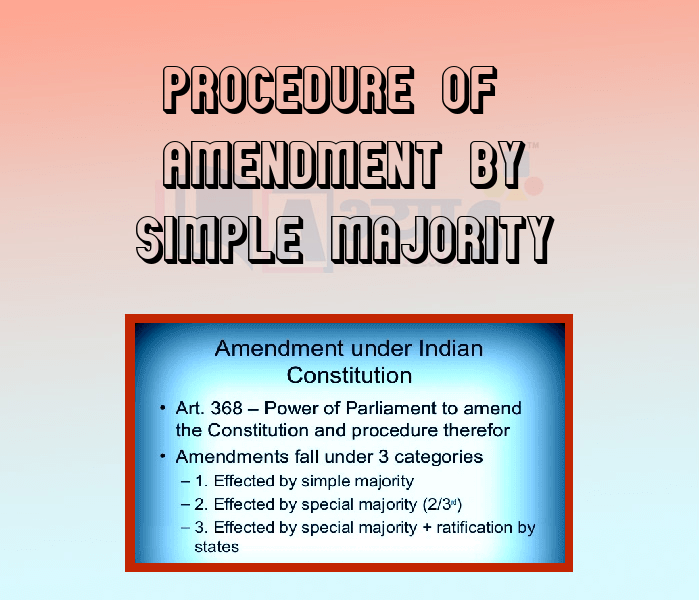Procedure of Amendment By Simple Majority











Procedure for Amendment by Simple Majority
Procedure for the Amendment of the Constitution
Article 368 mentions the amendment process. it has adopted three methods of amendment.
(1) Amendment procedure by simple majority
(2) Procedure for amendment by special majority of parliament
(3) Procedure for amendment with special majority of Parliament and and acceptance of State simple majority Legislatures.
Procedure for Amendment by Simple Majority
A bill passed by a simple majority of Parliament becomes law upon the assent of the president. under this, amendment can be done only by a simple majority of both the Houses of parliament.
(i) Entry of new states into the Union (Article 2)
(ii) Formation of new states into and change in area, extent and name of the state (Article 3)
(iii) On the request of the state Legislatures, Parliament can abolish or re - constitute the Second Hose (Legislative Councils) of State. (Article 169)
Under Article 169, on the request of the state Legislatures, _____________ can abolish or re - constitute the Second Hose (Legislative Councils) of State.
| |||
| Right Option : D | |||
| View Explanation | |||
Article _____________ mentions the amendment process. | |||
| Right Option : D | |||
| View Explanation | |||
Which of the following are correct : (a) Article 135 is related to the jurisdiction of the Supreme Court. (b) Article - 100 is related to the Quorum in Parliament. (c) Article - 105 is related to the Parliamentary Privilege. | |||
| Right Option : D | |||
| View Explanation | |||
Students / Parents Reviews [10]
My experience with Abhyas academy is very good. I did not think that my every subject coming here will be so strong. The main thing is that the online tests had made me learn here more things.

Hiya Gupta
8thMy experience with Abhyas is very good. I have learnt many things here like vedic maths and reasoning also. Teachers here first take our doubts and then there are assignments to verify our weak points.

Shivam Rana
7thIt was good as the experience because as we had come here we had been improved in a such envirnment created here.Extra is taught which is beneficial for future.

Eshan Arora
8thIt has a great methodology. Students here can get analysis to their test quickly.We can learn easily through PPTs and the testing methods are good. We know that where we have to practice

Barkha Arora
10thI have spent a wonderful time in Abhyas academy. It has made my reasoning more apt, English more stronger and Maths an interesting subject for me. It has given me a habbit of self studying

Yatharthi Sharma
10thIt was a good experience with Abhyas Academy. I even faced problems in starting but slowly and steadily overcomed. Especially reasoning classes helped me a lot.

Cheshta
10thAbout Abhyas metholodology the teachers are very nice and hardworking toward students.The Centre Head Mrs Anu Sethi is also a brilliant teacher.Abhyas has taught me how to overcome problems and has always taken my doubts and suppoeted me.

Shreya Shrivastava
8thA marvelous experience with Abhyas. I am glad to share that my ward has achieved more than enough at the Ambala ABHYAS centre. Years have passed on and more and more he has gained. May the centre flourish and develop day by day by the grace of God.

Archit Segal
7thAbhyas Methodology is very good. It is based on according to student and each child manages accordingly to its properly. Methodology has improved the abilities of students to shine them in future.

Manish Kumar
10thBeing a parent, I saw my daughter improvement in her studies by seeing a good result in all day to day compititive exam TMO, NSO, IEO etc and as well as studies. I have got a fruitful result from my daughter.
